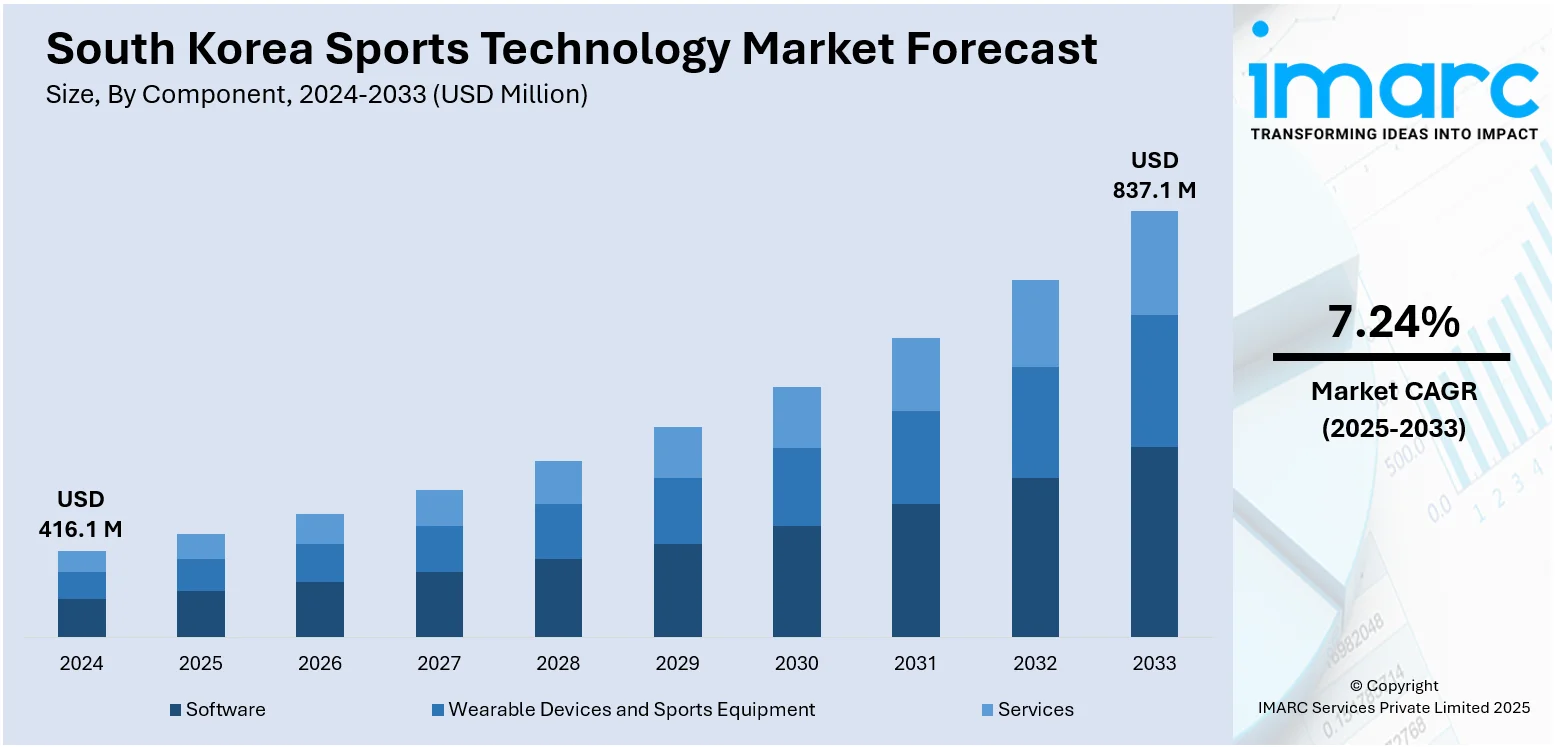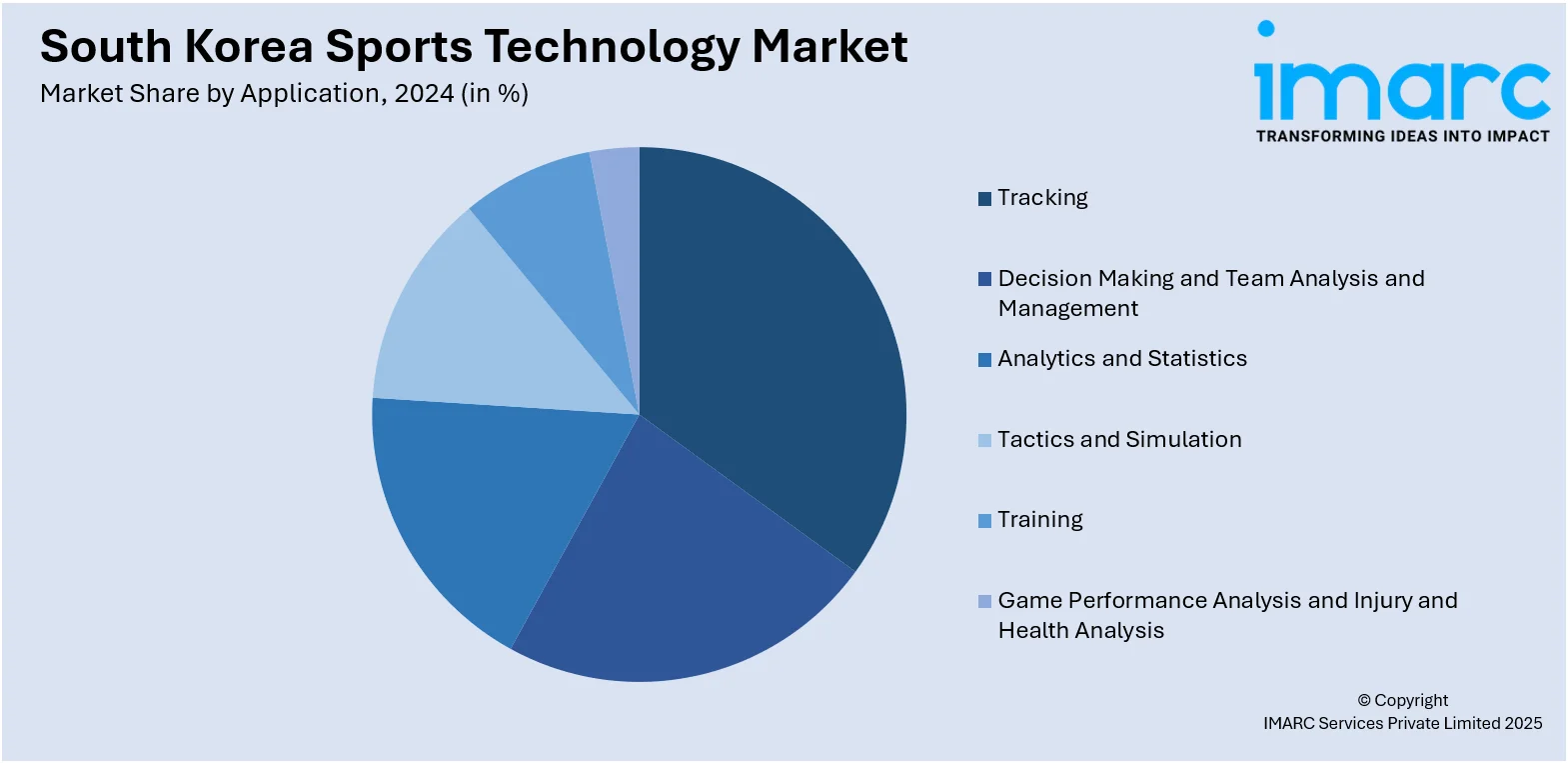
South Korea Sports Technology Market Size, Share, Trends and Forecast by Component, Technology, Sports, Application, End User, and Region, 2025-2033
South Korea Sports Technology Market Overview:
The South Korea sports technology market size reached USD 416.1 Million in 2024. The market is projected to reach USD 837.1 Million by 2033, exhibiting a growth rate (CAGR) of 7.24% during 2025-2033. The market is evolving rapidly, driven by innovation across various sectors such as wearables, smart equipment, data analytics, and virtual training platforms. Enhanced fan engagement tools and performance tracking systems are being widely adopted by athletes, teams, and organizations. Strategic partnerships and growing digital infrastructure continue to shape future growth. This comprehensive outlook highlights the expanding South Korea sports technology market share.
|
Report Attribute
|
Key Statistics
|
|---|---|
|
Base Year
|
2024 |
|
Forecast Years
|
2025-2033
|
|
Historical Years
|
2019-2024
|
| Market Size in 2024 | USD 416.1 Million |
| Market Forecast in 2033 | USD 837.1 Million |
| Market Growth Rate 2025-2033 | 7.24% |
South Korea Sports Technology Market Trends:
Precision officiating through automated systems
The integration of automated decision-making technologies in professional sports has significantly advanced in South Korea. Starting in the 2024 season, the national baseball league implemented an automated ball-strike adjudication system utilizing computer vision and machine learning. This technology enhances the accuracy and consistency of calls, reducing human error and controversial decisions during games. By employing synchronized multi-camera setups, the system tracks pitch trajectories with high precision, allowing for instant review and auditability. This innovation promotes fairness and improves the overall integrity of competition. The growing adoption of such automated officiating systems signals a broader digital transformation across multiple sports disciplines within the country. Efforts to extend similar technologies to other sports, such as goal-line decisions in football and timing in athletics, are already underway. The deployment of this system in 2024 demonstrates both governmental and league-level commitment to utilizing data-driven fairness. Such advancements have become pivotal contributors to the ongoing South Korea sports technology market growth.

To get more information on this market, Request Sample
Expansion of immersive virtual sporting experiences
Immersive virtual platforms are rapidly transforming how audiences engage with sports in South Korea. In March 2025, the virtual sports market in the country achieved revenue in millions, underscoring its growing commercial viability. These platforms combine high-speed networks with realistic simulation engines, enabling virtual training scenarios, fan-centric gamified content, and live event participation through avatars. They support multi-user interaction, realistic physics, and integration with live broadcasts, allowing remote participants to feel embedded in real-world competition. Virtual experiences also offer secondary monetisation channels such as premium access, interactive betting-like engagement, and in-event analytics. As infrastructure and platform sophistication improve, Korean sporting authorities are incorporating these tools into talent development pipelines, media strategies, and educational outreach. The result is a diverse ecosystem where physical sport, simulation, and digital fandom merge to create unified consumer experiences. These developments exemplify key South Korea sports technology market trends driving innovation and expanding engagement across the sporting ecosystem.
Wearable-driven performance intelligence
Wearable technologies that monitor biometric, physiological, and movement data have become essential tools for athletic performance enhancement in South Korea. These devices, equipped with miniaturised sensors, continuously track metrics such as heart rate variability, acceleration, and motion patterns without interfering with athletes’ performance during competition. Data collected from wearables is analysed in real time to provide insights into workload management, recovery optimization, and injury prevention. Supported by national policies promoting digital health and innovation, wearables are integrated into centralized athlete monitoring systems used by coaches and sports scientists. This allows for more personalised training programmes tailored to individual athletes’ needs, improving overall performance outcomes. The ongoing collection of longitudinal data further enables the detection of subtle trends in physical adaptation, enabling timely interventions. The adoption of wearable-driven analytics marks a shift towards continuous, data-informed athlete management and reflects the evolving landscape of sports science in South Korea. This technological progression plays a critical role in enhancing competitive success and athlete wellbeing.
South Korea Sports Technology Market Segmentation:
IMARC Group provides an analysis of the key trends in each segment of the market, along with forecasts at the country and regional levels for 2025-2033. Our report has categorized the market based on component, technology, sports, application, and end user.
Component Insights:
- Software
- Wearable Devices and Sports Equipment
- Services
The report has provided a detailed breakup and analysis of the market based on the component. This includes software, wearable devices and sports equipment, and services.
Technology Insights:
- Artificial Intelligence/Machine Learning (AI/ML)
- Internet of Things (IoT)
- Augmented Reality/Virtuality (AR/VR)
A detailed breakup and analysis of the market based on the technology have also been provided in the report. This includes artificial intelligence/machine learning (AI/ML), internet of things (IoT), and augmented reality/virtuality (AR/VR).
Sports Insights:
- Soccer
- Baseball
- Basketball
- Ice Hockey
- American Football/Rugby
- Tennis
- Cricket
- Golf
- Esports
- Others
The report has provided a detailed breakup and analysis of the market based on the sports. This includes soccer, baseball, basketball, ice hockey, American football/rugby, tennis, cricket, golf, esports, and others.
Application Insights:

- Tracking
- Decision Making and Team Analysis and Management
- Analytics and Statistics
- Tactics and Simulation
- Training
- Game Performance Analysis and Injury and Health Analysis
A detailed breakup and analysis of the market based on the application have also been provided in the report. This includes tracking, decision making and team analysis and management, analytics and statistics, tactics and simulation, training, and game performance analysis and injury and health analysis.
End User Insights:
- Coaches
- Clubs
- Leagues
- Sports Associations
- Others
The report has provided a detailed breakup and analysis of the market based on the end user. This includes coaches, clubs, leagues, sports associations, and others.
Regional Insights:
- Seoul Capital Area
- Yeongnam (Southeastern Region)
- Honam (Southwestern Region)
- Hoseo (Central Region)
- Others
The report has also provided a comprehensive analysis of all the major regional markets, which include the Seoul Capital Area, Yeongnam (Southeastern Region), Honam (Southwestern Region), Hoseo (Central Region), and others.
Competitive Landscape:
The market research report has also provided a comprehensive analysis of the competitive landscape. Competitive analysis such as market structure, key player positioning, top winning strategies, competitive dashboard, and company evaluation quadrant has been covered in the report. Also, detailed profiles of all major companies have been provided.
South Korea Sports Technology Market News:
- February 2025: SPOTV, South Korea's premier distributor of linear and digital sports programming, has joined with Imagine Communications to deploy an entirely automated playout system. This turnkey solution, derived from Imagine's Version integrated playout platform and ADC automation, allows SPOTV to distribute quick-turnaround live sports broadcasts throughout Southeast Asia from its broadcast facility in Cyberjaya, Malaysia. The system's scalability and reliability enable SPOTV's varied sports portfolio, which includes Wimbledon, the U.S. Open, MotoGP, and Major League Baseball.
- January 2024: SK Telecom has joined forces with Naver and AfreecaTV to boost sports broadcasting in South Korea through artificial intelligence. The three companies intend to offer customized viewing experiences by examining audience tastes and providing content suited to their desires. The AI will also be used to track and maximize advertisements during live streaming. The project is intended to rival those of LG Uplus and Coupang, making the trio formidable players in the changing sports media market.
South Korea Sports Technology Market Report Coverage:
| Report Features | Details |
|---|---|
| Base Year of the Analysis | 2024 |
| Historical Period | 2019-2024 |
| Forecast Period | 2025-2033 |
| Units | Million USD |
| Scope of the Report | Exploration of Historical Trends and Market Outlook, Industry Catalysts and Challenges, Segment-Wise Historical and Future Market Assessment:
|
| Components Covered | Software, Wearable Devices and Sports Equipment, Services |
| Technologies Covered | Artificial Intelligence/Machine Learning (AI/ML), Internet of Things (IoT), Augmented Reality/Virtuality (AR/VR) |
| Sports Covered | Soccer, Baseball, Basketball, Ice Hockey, American Football/Rugby, Tennis, Cricket, Golf, Esports, Others |
| Applications Covered | Tracking, Decision Making and Team Analysis and Management, Analytics and Statistics, Tactics and Simulation, Training, Game Performance Analysis and Injury and Health Analysis |
| End Users Covered | Coaches, Clubs, Leagues, Sports Associations, Others |
| Regions Covered | Seoul Capital Area, Yeongnam (Southeastern Region), Honam (Southwestern Region), Hoseo (Central Region), Others |
| Customization Scope | 10% Free Customization |
| Post-Sale Analyst Support | 10-12 Weeks |
| Delivery Format | PDF and Excel through Email (We can also provide the editable version of the report in PPT/Word format on special request) |
Key Questions Answered in This Report:
- How has the South Korea sports technology market performed so far and how will it perform in the coming years?
- What is the breakup of the South Korea sports technology market on the basis of component?
- What is the breakup of the South Korea sports technology market on the basis of technology?
- What is the breakup of the South Korea sports technology market on the basis of sports?
- What is the breakup of the South Korea sports technology market on the basis of application?
- What is the breakup of the South Korea sports technology market on the basis of end user?
- What is the breakup of the South Korea sports technology market on the basis of region?
- What are the various stages in the value chain of the South Korea sports technology market?
- What are the key driving factors and challenges in the South Korea sports technology market?
- What is the structure of the South Korea sports technology market and who are the key players?
- What is the degree of competition in the South Korea sports technology market?
Key Benefits for Stakeholders:
- IMARC’s industry report offers a comprehensive quantitative analysis of various market segments, historical and current market trends, market forecasts, and dynamics of the South Korea sports technology market from 2019-2033.
- The research report provides the latest information on the market drivers, challenges, and opportunities in the South Korea sports technology market.
- Porter's five forces analysis assist stakeholders in assessing the impact of new entrants, competitive rivalry, supplier power, buyer power, and the threat of substitution. It helps stakeholders to analyze the level of competition within the South Korea sports technology industry and its attractiveness.
- Competitive landscape allows stakeholders to understand their competitive environment and provides an insight into the current positions of key players in the market.
Need more help?
- Speak to our experienced analysts for insights on the current market scenarios.
- Include additional segments and countries to customize the report as per your requirement.
- Gain an unparalleled competitive advantage in your domain by understanding how to utilize the report and positively impacting your operations and revenue.
- For further assistance, please connect with our analysts.
 Request Customization
Request Customization
 Speak to an Analyst
Speak to an Analyst
 Request Brochure
Request Brochure
 Inquire Before Buying
Inquire Before Buying




.webp)




.webp)












